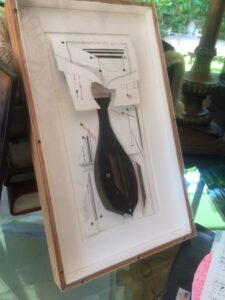 GF owns a surrealistic image of a businessman’s tie, rendered in paper and mounted in a three-dimensional structure of paper supported, and bounced, on little springs. I didn’t find a date on this mixed media collage, but it looks very 1980s.
GF owns a surrealistic image of a businessman’s tie, rendered in paper and mounted in a three-dimensional structure of paper supported, and bounced, on little springs. I didn’t find a date on this mixed media collage, but it looks very 1980s.
Art and artists of the 1980s now capture the interest of today’s art world. You might ask WHY the 80s? Isn’t that when we listened to Big Hair bands, and wore the WORST fashions ever? How good could 80s art BE?
Many important buyers of contemporary art today were BORN in the 1980s. When the art buying public reaches connoisseurship maturity, often collectors collect the era in which they were born. General styles of the 80s featured garish colors and lame attempts at pop art, and those poor abstractions hung in hotel lobbies. Indeed, terrible styles appear In every era, but we find great artists, despite the prevailing look of a certain era.
Mixed Media of the 80s
Good artists who reached the top of their careers IN the 1980s trained in the 1940s, post WWII. In the 80s we see a strong line reaching back to both Cubism and Surrealism ‘discovered’ in the previous generation. GF’s collage is a great example of surrealist construction of the 1980s by Robert Watson (1923-2004). He learned his technique from his teacher Frederic Taubes, who developed a style beginning in the 1920s. Thus, Watson grew as an artist. The influence of a teacher cannot be underestimated.
Watson became known for surrealistic cityscapes featuring the “lonely man.” The outcast man in a stark geometric built environment is his signature. He studied under Frederic Taubes, born in Poland in 1900, a master of painting techniques, craft, color, and oil medium. This tells us one important fact about understanding art: if you want to understand a work by a certain artist, look at the artist’s TEACHERS. Mentorship is a HUGE component of the artist’s world, one every artist understands. GF’s work offers a good example of this.
Taubes, Watson, and Mentorship
Here’s how that mentorship flowed in the case of Taubes and Watson. Taubes, a child of WWI, left Russian occupied Poland for Vienna in his teens. He studied at the Vienna Academy of Art, a traditional Academic school. After WWI, Taubes studied in Munich, exposed to “new” styles such as Cubism, Surrealism, German Expressionism, and Dada. His focus changed from Classical Old Master studies to works by Cezanne, de Chirico, Otto Dix, and Georg Grosz. Taubes was accepted to the art program at Weimar’s Bauhaus. There he learned a geometric approach to art and design.
To show you how this mentorship thing works in the art world, Taubes’ teacher at the Bauhaus was Johannes Itten (1888-1967), a teacher of techniques and the craft of painting. He authored THE book on color, The Art of Color: The Subjective Experience and Objective Rationale of Color (1973). Itten associated seasonal color palettes with four types of people, a theory later adopted by the cosmetics industry.
In 1930, the midst of the Depression, Taubes moved to NYC, and because only the very wealthy bought art, he painted portraits for wealthy society women. After WWII he taught. Portraiture was no longer the vogue, so he studied the Old Masters yet again. He published books on the craft of the Old Masters, and developed new pigments, based on the pigments used in the 14-15th century.
Watson studied with Taubes in the Midwest
Taubes’s attention to technique and geomantic style of his youth influenced Watson, who found his life oeuvre in Surrealism.
Watson moved to Berkeley and painted in that radical art scene, 1950-60s. He illustrated for Ray Bradbury (The Martian Chronicles, 1953), and exhibited at shows at Gumps and at the California Palace of the Legion of Honor.
If Watson’s teacher Taubes was a product of WWI, experiencing the subsequent new direction in art away from the Academic style that represented the Old World, Watson was a product of WWII, with that new direction towards unreal Realism (surrealism), geometric abstraction, and self-expression (Abstract Expressionism), after the tragedies of WWII.
When you sense the mentor behind the student you see the pedigree in works of art. And you see the influences of the era on both the mentor and the student. When an artist calls me to value their collection of art, I find works by their teachers and mentors in that collection.
GF’s collage is valued at $800.